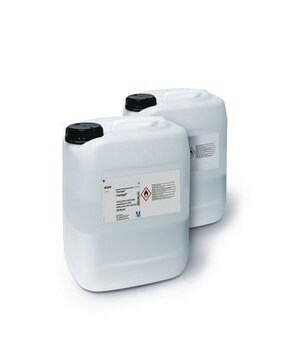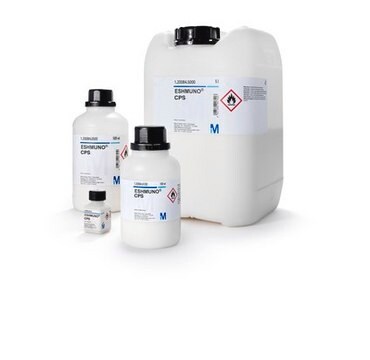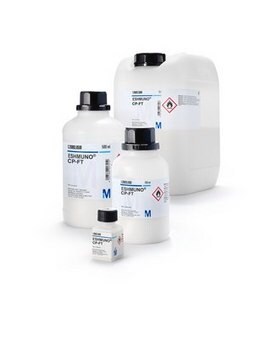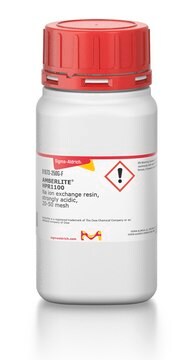추천 제품
ligand
(Sulfoisobutyl)
Quality Level
100
400
설명
strong cation exchanger, suspension in 20% ethanol and 150 mM NaCl (20-40 µm)
무균
sterile (Caustic Stable)
분석
≥90% (HPLC)
양식
resin
제조업체/상표
Calbiochem®
파라미터
8 bar max. pressure
80 cm/hr flow rate
기질 활성군
methacrylate
평균 입자 크기
20-40 um μm
용량
150 mg binding capacity (lysozyme/ml of resin)
전이 온도
flash point 35 °C (Does not sustain combustion.)
density
1.43 g/cm3 at 20 °C
벌크 밀도
1000 kg/m3
분리 기술
strong cation exchange
배송 상태
ambient
저장 온도
2-8°C
유사한 제품을 찾으십니까? 방문 제품 비교 안내
포장
- 1.16882.0100: Fractogel® EMD SO3- (S) Resin 100ml
- 1.16882.0010: Fractogel® EMD SO3- (S) Resin 10ml
- 1.16882.0500: Fractogel® EMD SO3- (S) Resin 500ml
- 1.16882.5000: Fractogel® EMD SO3- (S) Resin 5L
경고
Toxicity: Standard Handling (A)
분석 메모
Appearance: Milky turbid suspension, free from impurities (foreign particles)
Microscopic evaluation: Uniform spherical particles,no agglomerates,no fines
Extractable matter (water): ≤ 0.05 %
Cerium: ≤ 10 µg/g
Pressure drop(column: ID=1.6 cm, L=10 cm at 5 ml/min): ≤ 5.0 bar
Particle size (d10): 20 - 28 µm
Particle size (d50): 24 - 34 µm
Particle size (d90): 28 - 38 µm
Colony forming units (TAMC + TYMC): ≤ 100 CFU/ml
Endotoxins: ≤ 1.00 EU/ml
Protein binding capacity (lysozyme): 120 - 180 mg/ml
Functional test (c:d): ≤ 0.15
Functional test (b:a): ≤ 0.15
Functional test: Separation chymotrypsinogen A, cytochrom C and lysozyme
Microscopic evaluation: Uniform spherical particles,no agglomerates,no fines
Extractable matter (water): ≤ 0.05 %
Cerium: ≤ 10 µg/g
Pressure drop(column: ID=1.6 cm, L=10 cm at 5 ml/min): ≤ 5.0 bar
Particle size (d10): 20 - 28 µm
Particle size (d50): 24 - 34 µm
Particle size (d90): 28 - 38 µm
Colony forming units (TAMC + TYMC): ≤ 100 CFU/ml
Endotoxins: ≤ 1.00 EU/ml
Protein binding capacity (lysozyme): 120 - 180 mg/ml
Functional test (c:d): ≤ 0.15
Functional test (b:a): ≤ 0.15
Functional test: Separation chymotrypsinogen A, cytochrom C and lysozyme
법적 정보
CALBIOCHEM is a registered trademark of Merck KGaA, Darmstadt, Germany
FRACTOGEL is a registered trademark of Merck KGaA, Darmstadt, Germany
신호어
Warning
유해 및 위험 성명서
Hazard Classifications
Flam. Liq. 3
Storage Class Code
3 - Flammable liquids
WGK
WGK 1
Flash Point (°F)
95.0 °F
Flash Point (°C)
35 °C
시험 성적서(COA)
제품의 로트/배치 번호를 입력하여 시험 성적서(COA)을 검색하십시오. 로트 및 배치 번호는 제품 라벨에 있는 ‘로트’ 또는 ‘배치’라는 용어 뒤에서 찾을 수 있습니다.
D L Boyle et al.
The Journal of pharmacology and experimental therapeutics, 296(2), 495-500 (2001-02-13)
Adenosine (ADO) is a homeostatic inhibitory autocoid that is released at sites of inflammation and tissue injury, and exerts anti-inflammatory effects via multiple interactions at ADO receptor subtypes. Inhibition of ADO kinase (AK) increases extracellular ADO concentrations and AK inhibitors
E A Kowaluk et al.
The Journal of pharmacology and experimental therapeutics, 295(3), 1165-1174 (2000-11-18)
Adenosine kinase (AK; EC 2.7.1.20) is a key intracellular enzyme regulating intra-and extracellular concentrations of adenosine (ADO), an endogenous neuromodulator, antinociceptive, and anti-inflammatory autocoid. AK inhibition provides a means of potentiating local tissue concentrations of endogenous ADO, and AK inhibitors
R Suzuki et al.
British journal of pharmacology, 132(7), 1615-1623 (2001-03-27)
1. Adenosine (ADO) receptor activation modulates sensory transmission in the dorsal horn. Little is known about the circumstances underlying release of the purine. The present study was conducted to investigate the effect of a novel and potent non-nucleoside adenosine kinase
Jean De Vry et al.
European journal of pharmacology, 491(2-3), 137-148 (2004-05-14)
The chronic constriction injury model is a rat model of neuropathic pain based on a unilateral loose ligation of the sciatic nerve. The aim of the present study was to test its sensitivity to various clinically validated and experimental drugs.
M F Jarvis et al.
The Journal of pharmacology and experimental therapeutics, 295(3), 1156-1164 (2000-11-18)
Adenosine (ADO) is an inhibitory neuromodulator that can increase nociceptive thresholds in response to noxious stimulation. Inhibition of the ADO-metabolizing enzyme adenosine kinase (AK) increases extracellular ADO concentrations at sites of tissue trauma and AK inhibitors may have therapeutic potential
자사의 과학자팀은 생명 과학, 재료 과학, 화학 합성, 크로마토그래피, 분석 및 기타 많은 영역을 포함한 모든 과학 분야에 경험이 있습니다..
고객지원팀으로 연락바랍니다.



